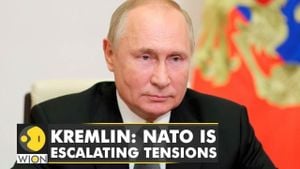Tensions between Taiwan and China have reached new heights as Taiwan's Ministry of National Defence (MND) reported increasing military activities near its borders. Recently, the MND detected five Chinese People's Liberation Army (PLA) aircraft, along with nine naval vessels operating close to Taiwan. This is just the latest round of military provocations from Beijing, which has escalated its military presence around Taiwan since September 2020.
According to the MND's statement, nine of the detected aircraft breached the median line, entering Taiwan's Air Defense Identification Zone (ADIZ) located both north and southwest of the island. "5 PLA aircraft, 9 PLAN vessels, and 1 official ship operating around Taiwan were detected up until 6 a.m. (UTC+8) today. 9 of the aircraft crossed the median line and entered Taiwan's northern and southwestern ADIZ. We have monitored the situation and responded accordingly," the statement said.
On the previous day, Taiwan's MND had already reported the detection of 24 PLA aircraft and six PLAN vessels. This period of heightened military activity seems to be part of China’s broader strategy of exerting pressure on Taiwan.
China's military maneuvers around Taiwan come off the back of frequent live-fire drills which cities like Taipei perceive as direct intimidation tactics. Notably, they symbolize Beijing's intense pressure on what it regards as a nation still claiming independence from Chinese sovereignty.
These drills and air sorties have led to heightened geopolitical tensions, particularly as Taiwan has been fortifying its defenses. Recently, Taiwan's President Lai Ching-te convened a national security conference where he reassured citizens about the government’s commitment to protecting Taiwan against potential threats. His reassurances come at a time when the Chinese military, under the guise of sizeable drills named "Joint Sword-2024B", is conducting military exercises meant as stark warnings to Taiwan's independence proponents.
Whispers of dissent against China's assertive policies are also echoing through the region. Many neighboring countries, including the Pacific island nation of Palau, are expressing concern about China's military advances. Palau’s President, Surangel Whipps Jr., stated the recent test-firing of Chinese intercontinental ballistic missiles (ICBMs) constituted a direct threat to his country's safety. The ICBM test, which crossed through Palau’s airspace, prompted President Whipps to call for increased security measures, including the potential deployment of U.S. Patriot missile systems.
This growing unease over Chinese military capabilities is reflected at recent defense exhibitions. At the Zhuhai Air Show, showcased technologies, particularly swarming drones and cutting-edge counter-drone systems, have captured attention. These defense systems are deemed pivotal for any conflict involving Taiwan, signaling the urgency with which nations are responding to the increasing military sophistication of the Chinese People's Liberation Army.
Experts view swarming drones, which can operate collectively to overwhelm adversaries, and new microwave-based counter-drone technologies as key developments amid rising tensions. These innovations are expected to play significant roles if military conflicts emerge over Taiwan's status.
Looking forward, the diplomatic engagements between China and the United States are being closely watched. U.S. President Joe Biden is set to meet Chinese President Xi Jinping to discuss their bilateral ties, amid rising tensions surrounding Taiwan. This meeting is aimed at curbing the increasing military activities surrounding the region and easing tensions.
While President Biden seeks dialogue to calm tensions, Taiwan’s administration remains adamant about bolstering its defenses against the looming threat from China. This dichotomy of pursuing peace pursuits through diplomacy alongside preparing militarily underlines the precarious status quo.
Political analysts continue to be concerned over China’s long-term military objectives. Some view these maneuvers as preparations for potential confrontation over Taiwan, particularly if Beijing believes the time is right to act on its long-standing claim over the island.
To conclude, Taiwan's situation remains increasingly delicate as Chinese military activities intensify, emphasizing the pressing need for regional security strategies and international diplomatic interventions. The interplay of military readiness and diplomatic engagements could very well shape the future of Taiwan within the broader geopolitical framework.



